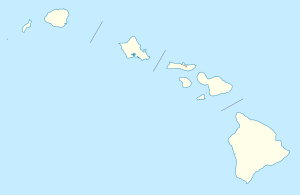Kakahaia National Wildlife Refuge facts for kids
Quick facts for kids Kakahaiʻa National Wildlife Refuge |
|
|---|---|
|
IUCN Category IV (Habitat/Species Management Area)
|
|
| Location | Molokaʻi, Hawaii, United States |
| Nearest city | Kaunakakai, Hawaii |
| Area | 44 acres (0.18 km2) |
| Established | 1977 |
| Governing body | U.S. Fish and Wildlife Service |
| Website | Kakahaia National Wildlife Refuge |
Kakahaiʻa National Wildlife Refuge (NWR) is a special place in Hawaii that helps protect nature. It was created in 1977 to keep important wetland homes safe for rare Hawaiian waterbirds and birds that fly there for winter. It also helps preserve an old Hawaiian fishpond.
Contents
Where is Kakahaiʻa Refuge Located?
This wildlife refuge is about 44 acres big. You can find it on the south coast of Molokaʻi island in Hawaii.
Unique Water Features
The refuge has a 15-acre coastal freshwater marsh. This marsh is actually part of an ancient Hawaiian fishpond. The pond gets its water from natural springs. It sits on a flat area near the ocean, at the base of volcanic hills.
In 1983, another water area was built. This 5.5-acre pond is managed to create shallow water. It's a perfect spot for wading birds to find food. Kamehameha V Highway cuts through the southern part of the refuge. This road lets people reach the coastal area. The County of Maui manages this part as a park.
Wildlife and Habitat: Who Lives Here?
Kakahaiʻa Refuge is home to 12 different kinds of birds. Some of these birds are very rare and endangered.
Endangered Birds
Two of the most important birds here are the Hawaiian stilt and the Hawaiian coot. These birds need special protection to survive.
Other Animals
Many other animals also live at the refuge. You can see migratory ducks and shorebirds, which are birds that live near the water. Sometimes, you might also spot animals like feral cats, dogs, mongooses, and axis deer. These animals are not native to Hawaii and can sometimes cause problems for the local wildlife.
The Pacific golden plover is a common shorebird you'll see. During the winter, many northern pintail ducks also visit the refuge.
Visiting Kakahaiʻa Refuge
You can visit the shoreline part of the refuge. This area is along Kamehameha V Highway.
Things to Do
The coastal part of the refuge is great for picnicking. You can also go fishing along the ocean beach. The inner part of the refuge is usually closed to the public. However, groups can get special permits for environmental education programs. This allows them to learn more about the refuge's wildlife and plants.
The refuge also has a very active group of volunteers. These volunteers help with many important tasks.
Protecting the Refuge: Management Activities
The people who manage Kakahaiʻa Refuge work hard to protect its unique environment.
Controlling Invasive Plants
More than 90% of the plants in the refuge are not native to Hawaii. These are called introduced species. Plants like Indian marsh fleabane and California bulrush grow very fast. They can take over and push out the native plants. This makes it hard for the local wildlife to find the food and shelter they need. For example, four out of five of the waterbird species here are endangered. This is partly because of these invasive plants.
Helping Endangered Species
The main goal of the refuge is to help endangered species survive and thrive. This is especially true for the Hawaiian waterbirds. The United States Fish and Wildlife Service manages the refuge. They control animals that might harm the birds, like predators. They also carefully manage the water levels in the ponds. This is very important during nesting season, when birds lay their eggs.


